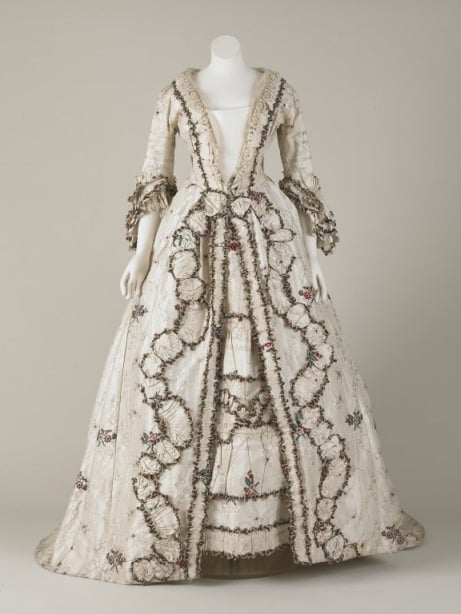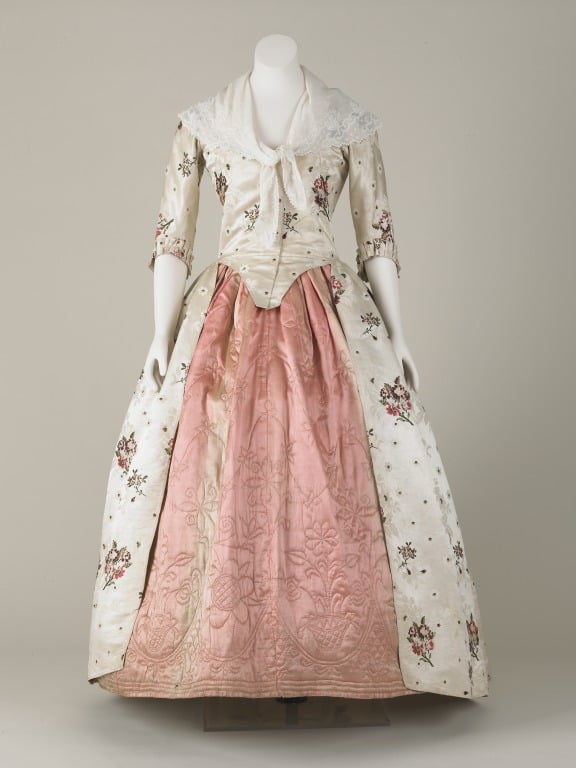Shapely calves and tiny waists: 18th century fashion @ the Walker Art Gallery
The most recent fashion display: Dressed to Impress – Fashion in the 18th Century at the Walker Art Gallery inspires two parallel emotions: awe at the craftsmanship and intricacy of the pieces in the show; and gratitude that we weren’t born in an age that requires corsets (ladies) and padded stockings (gents) for those shapely waists and calves. Maja Lorkowska talked to Pauline Rushton, Senior Curator at National Museums Liverpool to find out more.

First of all, where did the idea for the exhibition come from? “The previous show was much more modern (“Fashion Icons: Celebrating Gay Designers”) so the idea was to do something completely different. We had all of these amazing costumes and we never put them together before.” One of the key inspirations for the show was based on a previous curatorial experience: a video which shows the process of an 18th-century lady getting dressed with the help of her servants. From overly modest underwear to the multi-part dress and numerous layers of fabric and lace, the video became extremely popular with the public when it was first shown at the Lady Lever Art Gallery. “It made sense to build on this initial interest.”It’s worth mentioning that the video is shown as part of this exhibition too alongside a newly-made gentleman version. You can watch them both here but they are much better experienced in the presence of the garments themselves.
Pauline explains that the leading idea of the show is to talk about the “middling sort”, the people who weren’t actually middle class; instead they were aspirational and tried to improve their social standing. “I was trying to give an impression of the different styles that were worn by both men and women in different social settings.” For example, there is an impressive black, embroidered court suit (below) from the 1790s, which would have been worn by a man of quite high social status at the Royal Court. He would attend particular formal events, but only really to be seen. The suit is therefore a very eye-catching object, with an amount of detail that we rarely experience in the everyday objects of today and would surely draw the right kind of attention.

What about the fashion crazes of the time? “We’ve got this great collection of waistcoats, and I’ve put a selection out on display and show the different styles. They were quite long (knee-length!) to start with and they kept getting shorter, so that by the 1790s they were probably waist length.” While a waist-length waistcoat seems like a much more flattering option, they had some hidden, practical surprises too. Embroidered with a pattern, the garment on display also has buttons which were made of fabric. “They would usually embroider the shape on a big piece of silk first. There would be a row of buttons as well and the tailor would make that into a garment.” With this one, there are two buttons he hasn’t used under the arm in the same way that we get an extra button in a little plastic bag attached to a new coat. If any buttons got lost, the fabric could be swapped out, making for very convenient solution indeed.
Moving onto 18th-century body shaping techniques, we find that they weren’t much different from today. Possibly the most fascinating object on display is a pair of male stockings. As Pauline says: “They’re really rare. With these, it’s all about body shaping, in the same way that today you have push up bras. Back then having a shapely leg was very attractive.” The stockings have two layers, the first would be padded with wool to give the calf muscles a little boost and the other would be worn over the top to smooth it all out. “It was desirable, especially among wealthy people with servants, for their footmen to be very tall and have good legs. It was almost a sign of extra nobility.” It seems that spanx aren’t such a new invention after all…

And what about the female body shape? Pauline explains that “the modern idea of supporting the breast wasn’t there, everything was pushed up and out of the way and the shape of the stays (the 18th-century corset) was conical.” What is particularly interesting about these is the division of labour by gender in the process of production. “The staymaker, who was always a man, would come to the customer’s house and measure her. They would cut out the shapes which were sent to female outworkers female, to be stitched together. The idea was that only men were strong enough to actually force the shape.” Forcing isn’t something we want to imagine when it comes to fitting underwear and unsurprisingly, there had been numerous get accounts from angry husbands complaining about their wives being manhandled by strangers during the measuring process.
Clearly, fashion encompasses so much more than clothes. It can be the perfect vehicle for metaphorical time travel, as one of the most basic human necessities, customised according to the context and preferences of the time. The museum display even hints at the darkest corners of local history: it includes a men’s wallet which originally belonged to John Bridge, a Liverpool merchant heavily involved in the transatlantic slave trade. The object is proudly embossed with his name and profession in gold lettering and would have undoubtely held many valuable papers inside.
So there we have it. From status symbols to tastes and practical inventions, Dressed to Impress offers a glimpse into an earlier world, one certainly no less complex than that of today, albeit ever so slightly more uncomfortable.
‘Dressed to Impress’ is on display at the Walker Art Gallery until Spring 2020.
All images courtesy of Museum of Liverpool
Filed under: Fashion
Tagged with: 18thcentury, body, dress, fashion, history, museum, Museum of Liverpool, sewing, status, Walker Art Gallery



Comments